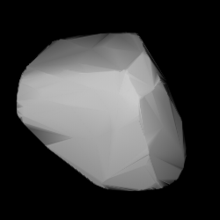astro.wikisort.org - Asteroid
Klymene (minor planet designation: 104 Klymene) is a large, dark Themistian asteroid that was discovered by J. C. Watson on September 13, 1868, and named after one of the many Clymenes in Greek mythology.[4] It is orbiting the Sun with a period of 5.60 years and an eccentricity of 0.16. The orbital plane is inclined by 2.8° to the plane of the ecliptic. It is classified as a C-type asteroid, indicating it probably has a carbonaceous composition. The spectra indicates the presence of aqueous-altered minerals on the surface[5] based upon a sharp feature at a wavelength of 3 μm, and, as of 2015, is the only member of the Themis family found to show this absorption.[6]
 3D convex shape model of 104 Klymene | |
| Discovery | |
|---|---|
| Discovered by | James Craig Watson |
| Discovery date | 13 September 1868 |
| Designations | |
MPC designation | (104) Klymene |
| Pronunciation | /ˈklɪmɪniː/[1] |
Alternative designations | A868 RB, 1893 FA 1951 OE, 1968 OS[2] |
Minor planet category | Main belt |
| Orbital characteristics[3] | |
| Epoch 31 July 2016 (JD 2457600.5) | |
| Uncertainty parameter 0 | |
| Observation arc | 130.58 yr (47693 d) |
| Aphelion | 3.6499 AU (546.02 Gm) |
| Perihelion | 2.65525 AU (397.220 Gm) |
Semi-major axis | 3.15256 AU (471.616 Gm) |
| Eccentricity | 0.15775 |
Orbital period (sidereal) | 5.60 yr (2044.5 d) |
Average orbital speed | 16.67 km/s |
Mean anomaly | 101.498° |
Mean motion | 0° 10m 33.888s / day |
| Inclination | 2.7905° |
Longitude of ascending node | 41.698° |
Argument of perihelion | 32.134° |
| Earth MOID | 1.66901 AU (249.680 Gm) |
| Jupiter MOID | 1.63907 AU (245.201 Gm) |
| TJupiter | 3.186 |
| Physical characteristics | |
| Dimensions | 123.68±3.1 km |
| Mass | 2.0×1018 kg |
Equatorial surface gravity | 0.0346 m/s² |
Equatorial escape velocity | 0.0654 km/s |
Synodic rotation period | 8.984 h (0.3743 d) |
Geometric albedo | 0.0568±0.003 |
| Temperature | ~157 K |
Spectral type | C |
Absolute magnitude (H) | 8.27 |
Based upon measurements made using adaptive optics at the W. M. Keck Observatory, this object may have a bi-lobed shape with a length of 163 ± 3 km and width of 103 ± 5 km, for an average dimension of 133 km.[7] This asteroid is located near the region of the Themis family but itself considered a background asteroid using HCM-analysis .[8] It is listed as a member of the Hecuba group of asteroids that orbit near the 2:1 mean-motion resonance with Jupiter.[9]
References
- Noah Webster (1884) A Practical Dictionary of the English Language
- Bowen, Eliza A. (1893), "Visualizing the Earth's annual motion", Popular Astronomy, 1: 178–179, Bibcode:1893PA......1..178B.
- Yeomans, Donald K., "104 Klymene", JPL Small-Body Database Browser, NASA Jet Propulsion Laboratory, retrieved 12 May 2016.
- Dictionary of minor planet names, International Astronomical Union. Springer, 2003, p. 25
- Fornasier, S.; et al. (February 1999), "Spectroscopic comparison of aqueous altered asteroids with CM2 carbonaceous chondrite meteorites", Astronomy and Astrophysics Supplement Series, 135 (1): 65–73, Bibcode:1999A&AS..135...65F, doi:10.1051/aas:1999161.
- Hargrove, Kelsey D.; et al. (July 2015), "Asteroid (90) Antiope: Another icy member of the Themis family?", Icarus, 254: 150–156, Bibcode:2015Icar..254..150H, doi:10.1016/j.icarus.2015.03.008.
- Marchis, F.; et al. (November 2006), "Shape, size and multiplicity of main-belt asteroids. I. Keck Adaptive Optics survey", Icarus, vol. 185, no. 1, pp. 39–63, Bibcode:2006Icar..185...39M, doi:10.1016/j.icarus.2006.06.001, PMC 2600456, PMID 19081813.
- Moore, Patrick; Rees, Robin, eds. (2011), "Patrick Moore's Data Book of Astronomy", Patrick Moore's Data Book of Astronomy by Patrick Moore and Robin Rees. Cambridge University Press (2nd ed.), Cambridge University Press: 165, Bibcode:2011pmdb.book.....M, ISBN 9781139495226.
- McDonald, Sophia Levy (June 1948), "General perturbations and mean elements, with representations of 35 minor planets of the Hecuba group", Astronomical Journal, vol. 53, p. 199, Bibcode:1948AJ.....53..199M, doi:10.1086/106097.
External links
- 104 Klymene at AstDyS-2, Asteroids—Dynamic Site
- 104 Klymene at the JPL Small-Body Database
На других языках
[de] (104) Klymene
(104) Klymene ist ein Asteroid, der nach Klymene, einer der Okeaniden genannten Töchter des Titanen Okeanos und Mutter des Prometheus, benannt wurde.- [en] 104 Klymene
[es] (104) Klymene
(104) Klymene es un asteroide perteneciente al cinturón de asteroides descubierto el 13 de septiembre de 1868 por James Craig Watson desde el observatorio Detroit de Ann Arbor, Estados Unidos. Está nombrado por Clímene, un personaje de la mitología griega.[2][ru] (104) Климена
(104) Климена (лат. Klymene) — астероид из группы главного пояса, который принадлежит к тёмному спектральному классу C[1] и входит в состав семейства Фемиды[2] . Он был открыт 13 сентября 1868 года американским астрономом Дж. К. Уотсоном в Детройтской обсерватории, США и назван в честь одного из 10 персонажей древнегреческой мифологии с именем Климена[3].Другой контент может иметь иную лицензию. Перед использованием материалов сайта WikiSort.org внимательно изучите правила лицензирования конкретных элементов наполнения сайта.
WikiSort.org - проект по пересортировке и дополнению контента Википедии